One pot green synthesis of m-aminophenol–urea–glyoxal resin as pipette tip solid-phase extraction adsorbent for simultaneous determination of four plant hormones in watermelon
Bạn đang xem bản rút gọn của tài liệu. Xem và tải ngay bản đầy đủ của tài liệu tại đây (2.55 MB, 8 trang )
Journal of Chromatography A 1623 (2020) 461214
Contents lists available at ScienceDirect
Journal of Chromatography A
journal homepage: www.elsevier.com/locate/chroma
One pot green synthesis of m-aminophenol–urea–glyoxal resin as
pipette tip solid-phase extraction adsorbent for simultaneous
determination of four plant hormones in watermelon juice
Yanke Lu a, Pengfei Li a, Chunliu Yang a,∗, Yehong Han b, Hongyuan Yan a,b,∗
a
Key Laboratory of Medicinal Chemistry and Molecular Diagnosis of Ministry of Education, College of Public Health, Hebei University, Baoding 071002,
China
Key Laboratory of Analytical Science and Technology of Hebei Province, College of pharmacy, Hebei University, Baoding 071002, China
b
a r t i c l e
i n f o
Article history:
Received 16 March 2020
Revised 3 May 2020
Accepted 5 May 2020
Available online 8 May 2020
Keywords:
One pot fabrication
Resin adsorbent
Pipette tip solid-phase extraction
Plant hormones
Watermelon juice
a b s t r a c t
Plant hormones (PHs) are a type of pesticide that can potentially affect human health. Therefore,
their quantitative detection is particularly important. In this study, a green and economic method
for the simultaneous extraction and determination of four PHs, namely thidiazuron, forchlorfenuron,
1-naphthylacetic acid, and 2-naphthoxyacetic acid, in watermelon juice was developed by using maminophenol–urea–glyoxal resin as the adsorbent for pipette tip solid phase extraction (PT-SPE) coupled
with liquid chromatography. The resin was synthesized via a simple (one pot hydrothermal synthesis)
and green (ethanol as the solvent and glyoxal as crosslinking agent) process. The synthesized resin possesses multiple functional groups (hydroxyl, amino, and imino, among others), high adsorption capacity,
larger specific surface area than the urea–glyoxal resin and m-aminophenol–glyoxal resin, and can be
regenerated easily. The PT-SPE device is simple, cheap, and easy to obtain, and the adsorbent dosage is
only 5.0 mg. The proposed method has a wide linear detection range, high recovery, good precision, and
high sensitivity, and satisfies the measurement requirements for detecting trace levels of PHs in fruits
and vegetables.
© 2020 Elsevier B.V. All rights reserved.
1. Introduction
Sample preparation, as a key step in modern analysis, plays an
important role in the entire analysis process. Currently, the development of new, economical, fast, and high-throughput sample pretreatment methods is still an urgent issue in the analytical field.
Sample pretreatment technologies include solid-phase extraction
(SPE) [1], solid-phase microextraction [2,3], liquid–liquid extraction
[4], matrix solid-phase dispersion [5], dispersive liquid–liquid microextraction [6], pipette tip SPE (PT-SPE) [7]. Among them, SPE
and methods derived therefrom are the most widely used technologies, especially the PT-SPE method have received widespread
attention from researchers because of its advantages of low cost,
small dead volume, longer flow path, and low consumption of the
adsorbent and organic solvent [8]. However, SPE and related methods are dependent on the adsorption performance of the adsor-
∗
Corresponding authors at: Key Laboratory of Medicinal Chemistry and Molecular Diagnosis of Ministry of Education, College of Public Health, Hebei University,
Baoding 071002, China.
E-mail addresses: (C. Yang), (H. Yan).
/>0021-9673/© 2020 Elsevier B.V. All rights reserved.
bent; therefore it is necessary to explore new adsorbents with excellent adsorption and purification abilities.
Phenolic resin, as a commercial synthetic resin, is widely used
in a variety of fields, including in adsorbent owing to its low cost,
easy availability, and simple preparation procedure [9,10]. Phenol–
formaldehyde resins are conventionally utilized, but formaldehyde,
used as the crosslinker, is carcinogenic. Therefore, researchers have
attempted to find alternative crosslinking agents, such as glutaraldehyde, glyoxylic acid, hexamethylenetetramine, and glyoxal
[11–15]. Although the toxic side effects of the aforementioned adsorbents to the human body are relatively low, the functional
groups of the phenolic resin are still limited as only phenolic hydroxyl groups are present in these resins, which in turn affects the
adsorption ability. Therefore, the development of new multifunctional phenolic resin adsorbents has become a hot research topic.
Plant hormones (PHs) are widely used in modern agriculture
to increase crop yields [16–23]. Thidiazuron (TDZ), forchlorfenuron
(CPPU), 1-naphthylacetic acid (NAA), and 2-naphthoxyacetic acid
(BNOA), as PHs, regulate watermelon growth, and have been
widely used in different periods [24,25]. Currently, watermelon
juice has become one of the most popular fruit drinks in the sum-
2
Y. Lu, P. Li and C. Yang et al. / Journal of Chromatography A 1623 (2020) 461214
mer, but long-term consumption of watermelon juice containing
high-dose residues of PHs can cause a series of diseases [26,27].
Therefore, many countries and organizations, such as the European
Union, United States, Australia, and China have been established
maximum residue limits for PHs [28–31]. However, it is difficult
to quantitatively analyze PHs in watermelon juice because of the
complicated nature of the sample matrix and trace levels of PHs.
Therefore, establishing an accurate and efficient analytical method
for the simultaneous determination of PHs in watermelon juice is
desired.
In this work, aminophenol–urea–glyoxal resin (MAPUGR) with
multiple functional groups is synthesized by using aminophenol and urea as bifunctional monomers, low toxicity glyoxal as
the crosslinking agent to replace carcinogenic formaldehyde, and
polyethylene glycol 60 0 0 (PEG 60 0 0) as a porogen. Aminophenol–
glyoxal resin (MAPGR) and urea–glyoxal resin (UGR) are also synthesized, and the adsorption capacity of the three adsorbents is
compared. A small PT-SPE cartridge is assembled by using a pipette
tip, degreased cotton, and rubber suction bulb. Finally, a method
based on MAPUGR−PT-SPE coupled with high performance liquid
chromatography (HPLC) for detecting these four PHs in watermelon
juice is established by utilizing the optimized extraction parameters.
Fig. 1. Assembly and operation process of MAPUGR−PT-SPE.
2. Experimental section
2.1. Reagents and instruments
The details are displayed in the Supplementary material.
2.2. Synthesis of MAPUGR, MAPGR, and UGR
Synthesis of MAPUGR: Aminophenol (30 mmol), urea
(10 mmol), PEG 60 0 0 (0.015 mmol), and anhydrous ethanol
(50 mL) were added to a flask (100 mL) and stirred until thoroughly mixed. Glyoxal (30 mmol) was added, and pH of the
solvent was adjusted to 9.0 with NaOH solution, the resulting
solution was stirred at 50 °C for 3 h. After heating at 75 °C for
24 h, the solid product was washed with methanol and water, and
then dried at 40 °C to obtain MAPUGR.
Synthesis of MAPGR: Aminophenol (40 mmol), PEG 60 0 0
(0.015 mmol), and anhydrous ethanol (50 mL) were added to
a flask (100 mL) and stirred until thoroughly mixed. Glyoxal
(30 mmol) was added and the pH of the system was adjusted to
9.0 with NaOH solution; the resulting solution was stirred at 50 °C
for 3 h. After heating at 75 °C for 24 h, the resulting solid product
was washed with methanol and water, and then dried at 40 °C to
obtain MAPGR.
Synthesis of UGR: Urea (40 mmol), PEG 60 0 0 (0.015 mmol), and
anhydrous ethanol (50 mL) were added to a flask (100 mL) and
stirred until thoroughly mixed. Glyoxal (30 mmol) was added, the
pH of the system was adjusted to acidic with HCl solution, the resulting solution was stirred at 50 °C for 3 h. After heating at 75 °C
for 24 h, the obtained solid product was washed with methanol
and water, and then dried at 40 °C to obtain UGR.
2.3. Preparation of watermelon juice
Watermelon samples were randomly purchased from the local
supermarkets in Baoding China. First, the watermelons were homogenized with a homogenizer after peeling. The supernatant was
obtained after centrifugation at 10 0 0 0 rpm for 10 min to remove
the solid residues, and the supernatant was stored frozen in a refrigerator. Finally, the samples were passed through a 0.45 μm filter for further work.
2.4. Procedure for MAPUGR−PT-SPE
The PT-SPE was assembled from two pipette tips, degreased
cotton and the adsorbent, as shown in Fig. 1. First, degreased cotton was inserted into the exit of the 200 μL pipette tip to avoid
loss of the adsorbent. Thereafter 5.0 mg of MAPUGR was added to
the 200 μL pipette tip. The top of the adsorbent was then covered
with degreased cotton. A 1.0 mL pipette tip that was cut off was
connected to the 200 μL pipette tip filled with adsorbent. The final
height of the adsorbent in the PT-SPE was approximately 10 mm.
After activating MAPUGR with 2.0 mL of methanol and water, watermelon juice (1.0 mL) at pH 3.0 was loaded onto the cartridge,
washed with water (1.0 mL), and eluted with methanol (1.0 mL).
The tip of a rubber suction bulb was tightly inserted into the top
of the pipette tip. The pressure above the sample solution was controlled by squeezing the rubber suction bulb through a clamp fixed
on an iron stand to control the flow rate. The eluate was collected,
dried under nitrogen, and then re-dissolved in 1.0 mL of the mobile phase for HPLC analysis.
2.5. HPLC conditions
Chromatographic separation was performed on an LC–20A high
performance liquid chromatograph equipped with an LC–20AT solvent delivery unit and an SPD−20A ultraviolet detector (Shimadzu,
Kyoto, Japan). A Labsolution workstation was used for data acquisition (Shimadzu, Kyoto, Japan). An Eclipse XDB–C18 column
(4.6 × 150 mm, 5 mm) was purchased from Agilent Tech. Co., Ltd.
(California, United States). The wavelength of the detection was set
at 224 nm. The mobile phase comprised water-acetonitrile (72:28,
v/v, containing 0.1% TFA) at a flow rate of 1.0 mL min−1 . The column temperature was maintained at 40 °C, and the injection volume was 20 μL.
2.6. Statistical analysis
The confidence interval is represented by an error bar. Because
comparisons among three or more sample means were to be performed, one-way analyses of variance and multiple comparison
Student−Newman−Keuls (SNK-q) were selected to analyze the sig-
Y. Lu, P. Li and C. Yang et al. / Journal of Chromatography A 1623 (2020) 461214
3
Fig. 2. Schematic illustration of MAPUGR synthesis.
nificant differences. Mean values were considered to have a significant difference when the significance test value (P) < 0.05.
3. Results and discussion
3.1. Synthesis of MAPUGR, MAPGR, and UGR
The purpose of the MAPUGR adsorbent synthesized herein was
to extract and isolate four PHs in watermelon juice. An attempt
was made to synthesize the resin using m-aminophenol and urea
with glyoxal to meet the requirements for pretreatment of the
complex sample. The synthesis process and reaction principle of
the adsorbent are shown in Fig. 2. The methylolated intermediate was first formed from m-aminophenol, urea and glyoxal in
ethanol. After increasing the temperature, the intermediate polycondensed and solidified, and PEG 60 0 0 was also uniformly fixed
in the solid product. After washing the product with methanol
and water, the unreacted monomers, crosslinker, and porogen in
the solid product were removed, and the spatial arrangement of
the MAPUGR structure was maintained by vacuum drying. The
hydrophilic groups of m-aminophenol and urea were retained in
the product, which provided numerous adsorption sites and enhanced the hydrophilicity of the sorbent. Glyoxal containing two
aldehyde groups provides adequate reaction sites, and was used as
a crosslinking agent in the synthesis of MAPUGR. PEG 60 0 0, as a
porogen and structure-directing agent, plays an important role in
the formation of the three-dimensional porous structure of MAPUGR. Anhydrous ethanol, as the reaction solvent in this experiment, does not exert the toxic effects of organic solvents on the
human body and the environment, and thus enables green synthesis of the polymer.
3.2. Characteristics of MAPUGR, MAPGR, and UGR
Fig. 3A shows the scanning electron microscope (SEM) image of
MAPGR, which revealed that the product formed by the reaction
of m-aminophenol with glyoxal had a non-uniform particle size
with close adhesion of the components. The average particle size
of the individual microspheres was 3−5 μm, and the particle size
of the adhesion structure was 5−30 μm. The SEM image of UGR in
Fig. 3B shows a sheet-like adhesion structure with a particle size
of 2–30 μm. The SEM image of MAPUGR in Fig. 3C shows the overall three-dimensional porous structure formed by the aggregation
of multiple microspheres. The microspheres/microspheres junction
may be producted by the reaction of glyoxal with urea. The size of
the individual microspheres is 1–3 μm, but the overall particle size
is 30–100 μm. The particle size of MAPUGR satisfies the application range of SPE, and the solid layer formed by the aggregation of
the microspheres in the three-dimensional network structure ensures that MAPUGR is in sufficient contact with the sample solution when loaded into the PT-SPE device.
The functional groups of MAPUGR, MAPGR and UGR were confirmed by Fourier-transform infrared spectrometry (FT–IR). Broad
adsorption peaks were found at 3342 and 3232 cm−1 due to the
N–H and O–H telescopic vibrations, and the peak of the C–H
stretching vibration was appeared at 2973 cm−1 . Furthermore, the
stretching vibration of the C=O group of urea was observed at
1689 cm−1 , and the peaks associated with the C=C group in the maminophenol benzene ring skeleton were observed at 1612, 1493,
and 1460 cm−1 . The peaks at 1304, 1203, 1161, and 1105 cm−1
were attributed to C–O and C–N tensile vibrations. Finally, the signals at 809 and 766 cm−1 were attributed to the out-of-plane
bending vibration of C–H in the aromatic ring, respectively. These
results indicate that the amino and phenolic hydroxyl groups in maminophenol, the carbonyl group in urea, and the hydroxyl group
from the reaction of urea and glyoxal were successfully introduced
into MAPUGR.
The surface area and pore characteristics are listed in Table S1.
The average pore diameters of MAPUGR, MAPGR, and UGR were
˚ respectively. The surface area of MA96.42, 131.54, and 176.86 A,
PUGR is 2.02 and 1.67 times that of MAPGR and UGR, respectively.
The adhesion of MAPGR results in a small specific surface area.
However, during the synthesis of MAPUGR, the addition of urea
effectively prevented the adhesion of MAPGR; therefore, the synthesized MAPUGR had a high specific surface area.
3.3. Evaluation of adsorption behavior
The adsorption capacity of MAPGR, UGR and MAPUGR for
the four PHs was evaluated by adding 2.0 mL of solution
(30.0 μg mL−1 of the analytes) to a 10 mL centrifuge tube containing 3.0 mg of adsorbent. As shown in Fig. 4A, MAPUGR had
a higher adsorption capacity for the four PHs than MAPGR and
UGR (P < 0.05). This further confirmed that the addition of urea
during the preparation procedure enhanced the adsorptive interactions with the analytes and increased the surface area, which
improved the adsorption capacity of MAPUGR. The experimental
steps for evaluating the adsorption kinetics are presented in the
Supplementary material. As shown in Fig. S1, the adsorption capacity of MAPUGR for TDZ, CPPU and BNOA could exceed 45% of the
adsorption capacity at adsorption equilibrium, and the adsorption
capacity of NAA could exceed 33% of the adsorption capacity at
adsorption equilibrium within 5 min. Therefore, the mass trans-
4
Y. Lu, P. Li and C. Yang et al. / Journal of Chromatography A 1623 (2020) 461214
Fig. 3. SEM of MAPGR (A), UGR (B), and MAPUGR (C).
fer rate of MAPUGR satisfies the requirements for extraction of the
four PHs.
3.4. Optimization of the MAPUGR−PT-SPE process
The molecular forms of the compounds may be affected by the
sample pH, which has an effect on the recovery of the four PHs.
When the sample pH is less than the pKa, the analytes are predominantly in the molecular or protonated form, which facilitates
adsorption of the analytes by the adsorbent. The pKa values of TDZ,
CPPU, NAA, and BNOA were 8.86, 8.40, 4.26, and 4.75, respectively,
and pH of the watermelon juice was 5.63; thus, the sample pH was
adjusted in the range from 2.0 to 7.0 with 1 M HCl and 1 M NaOH.
Fig. 4B shows that pH had a strong influence on the adsorption of
NAA and BNOA (P < 0.05), but had little effect on TDZ and CPPU
(P > 0.05). Therefore, the sample pH was optimized to 3.0.
The loading volumes (1.0, 1.5, 2.0, 2.5, and 3.0 mL) of the samples were studied. Fig. 4C shows that the loss rate of the analytes gradually increased (P < 0.05) with increasing loading volume, which indicates that limited adsorption could be achieved
with 5.0 mg of the adsorbent, and dynamic adsorption equilibrium
was not reached. Considering the extraction speed and efficiency,
a loading volume of 1.0 mL was used for further work. The washing solvent can effectively remove interfering substances. Thus,
1.0 mL of water, methanol–water (1:9, v/v), acetonitrile–water (1:9,
v/v), acetone–water (1:9, v/v), water–hydrochloric acid (pH 3), and
water–acetic acid (pH 3) were studied as the washing agent. As
shown in Fig. 4D, there was almost no loss of the analytes when
water–hydrochloric acid (pH 3) or water was used as the washing agent (P > 0.05). Considering the purification effect and cost,
1.0 mL of water was used for the subsequent work. Six eluents
were studied for elution of the analytes from MAPUGR; the results
presented in Fig. 4E show that the recovery of four PHs was the
highest when methanol was used as eluent (P < 0.05). The effect
of different eluent volumes (0.20, 0.40, 0.60, 0.80, 1.0, and 1.2 mL)
on the analyte recovery was also investigated. As shown in Fig. 4F,
the optimal recovery was achieved when the eluent volume was
1.0 mL (P > 0.05).
3.5. Comparison with commercial adsorbents
A spiked recovery experiment was used to evaluate the extraction efficiency of MAPUGR and seven commercial adsorbents (C18 ,
HLB, MCX, PSA, SCX, silica gel, and MAX) for the four PHs in watermelon samples. The procedure for MAPUGR–PT-SPE was performed as described in the Experimental Section, and the extraction conditions for HLB, MCX, C18 , PSA, SCX, silica, and MAX are
described in previous studies [32–35]; the results are presented in
Fig. 5 and Fig. S2. MAPUGR had higher recoveries for the four PHs
than the commercial adsorbents (P < 0.05). MCX provided excellent recovery (>80%) because it is a cation exchange and reverse-
phase dual-retention mode adsorbent, whereas the anionic adsorbents (MAX, PSA) presented low recoveries for the PHs, indicating
that the cation exchange and reverse-phase dual-retention play an
important role in the adsorption process. In addition, the recovery
of SCX, dominated by π –π bonds, was low (<32%), which proves
that π –π bonds are not the main force between the analytes and
adsorbent. This phenomenon is attributed to the large number of
hydroxyl groups, amino groups, and imino groups on the surface
of the adsorbent, which sterically hinder π –π bonding. However,
the weakly polar analytes were minimally adsorbed on the polar
adsorbents (silica, PSA) in aqueous medium, whereas higher recovery for the analytes was achieved with the strongly nonpolar
adsorbent (C18 ), indicating that the nonpolar interactions with the
analytes play an important role. Finally, more than 92% of the four
PHs was recovered with HLB, which proves that the hydrophilicity and hydrogen bonding of the adsorbent contribute significantly
to the adsorption of the PHs. Overall, MAPUGR undergoes multiple adsorptive interactions with the analytes due to its excellent
hydrophilicity.
3.6. Adsorbent regeneration
The reusability of MAPUGR was investigated by an adsorptiondesorption cycle experiment by following the procedure described
in the Experimental Section. The concentration of the spiked solution was 5.00 μg mL−1 . When the MAPUGR–PT-SPE process was
completed, the cartridge was cleaned with 2.0 mL of methanol and
water, respectively, before the next cycle. The recovery was still
higher than 92% after 6 cycles, which indicates that MAPUGR has
good reusability. The entire process only uses water and methanol,
which extends the life of the adsorbent and makes it easy to regenerate.
3.7. Validation of MAPUGR–PT-SPE–HPLC method
The proposed method was validated by determining its linearity, limit of detection (LOD), limit of quantitation (LOQ), repeatability, accuracy and precision; the results are summarized in Table 1.
A good linearity curve was obtained in the range of 0.020 0/0.050 0–
5.00 μg mL−1 for the four PHs (seven spiked levels of the analytes)
with a correlation coefficient (r2 ) ≥ 0.9998. The LOD and LOQ calculated for the signal-to-noise ratios (S/N) of 3 and 10 were 10.9,
14.4, 3.61, and 4.77 ng mL−1 , and 36.3, 48.1, 12.0, and 15.9 ng mL−1
for TDZ, CPPU, NAA, and BNOA, respectively. The precision of the
developed method was evaluated by repeatedly analyzing the sample solution (5.00 μg mL−1 ) three times on the same day (n = 3)
and on three consecutive days. The intra-day and inter-day precisions are expressed as the relative standard deviations (RSDs)
were in the range of 2.5–3.3% and 2.1–7.7%, respectively. Finally,
the recovery determined at three spiking levels (0.050 0, 0.50 0, and
5.00 μg mL−1 ) was 87.2–102.3% with RSDs of 1.6–7.2% (Table 2).
Y. Lu, P. Li and C. Yang et al. / Journal of Chromatography A 1623 (2020) 461214
5
Fig. 4. Comparison of adsorbents (A) and optimization of MAPUGR–PT-SPE (B–F).
Table 1
Parameters of the MAPUGR–PT-SPE–HPLC method.
Analytes
Regression equation
TDZ
CPPU
NAA
BNOA
y
y
y
y
=
=
=
=
7.4
8.9
5.3
4.4
×
×
×
×
104 x+4.9 × 102
104 x+4.4 × 102
105 x-3.6 × 103
105 x-5.2 × 103
r2
Linearity (μg mL−1 )
LOD (ng mL−1 )
LOQ (ng mL−1 )
0.9998
0.9998
0.9999
0.9998
0.0500–5.00
0.0500–5.00
0.0200–5.00
0.0200–5.00
10.9
14.4
3.61
4.77
36.3
48.1
12.0
15.9
RSD (%)
Intra-day
Inter-day
3.3
2.5
2.6
2.9
7.7
3.5
6.6
2.1
6
Y. Lu, P. Li and C. Yang et al. / Journal of Chromatography A 1623 (2020) 461214
Table 2
Spiked recoveries for the MAPUGR–PT-SPE–HPLC method (n = 3).
Analytes
TDZ
CPPU
NAA
BNOA
0.0500 μg mL−1
0.500 μg mL−1
5.00 μg mL−1
Recovery (%)
RSD (%)
Recovery (%)
RSD (%)
Recovery (%)
RSD (%)
93.1
96.6
87.2
102.3
7.2
2.5
5.8
4.2
88.8
101.6
90.9
92.3
2.5
3.8
3.2
2.9
97.4
98.3
96.2
95.7
2.1
2.4
1.6
2.9
taneous determination of trace levels of TDZ, CPPU, NAA and BNOA
in watermelon juice.
3.9. Method comparison
Fig. 5. Comparison of MAPUGR with commercial adsorbents.
A comparison of the proposed method with other methods for
detecting PHs in fruits and vegetables is shown in Table 3. The LOD
of the developed method is comparable to or lower than that of
SPE–GC and SPE–HPLC, where SPE requires at least 30 mg of adsorbent; thus, the consumption of adsorbents and organic reagents
in these methods is obviously large. Compared with SPE–HPLC–
MS/MS, the developed method has a higher LOD, but the expensive instrumentation of HPLC–MS limits its applicability in routine
analysis. Compared with other methods, PT-SPE as a sample pretreatment technology has the advantages of requiring less adsorbent and reagent consumption, while affording high recovery. In
addition, the developed MAPUGR–PT-SPE–HPLC method does not
require special or expensive equipment, and thus can be used as
an effective strategy for the routine detection of PHs in fruits and
vegetables.
4. Conclusions
A green and economical MAPUGR–PT-SPE–HPLC process was
developed for the extraction and determination of four PHs in watermelon juice. MAPUGR, synthesized via simple one pot precipitation polymerization, combines the advantages of MAPGR and
UGR, increases the specific surface area, enriches surface functional
groups and interaction, and changes the framework structure to
provide more contact between the adsorbent and analytes. The PTSPE device is simple, cheap, and easy to obtain, and the adsorbent
dosage is only 5.0 mg. The recovery of four PHs at three spiking
levels ranged from 87.2% to 102.3% with an RSD ≤ 7.2%, which
is consistent with the requirements for monitoring PHs in watermelon juice.
Declaration of Competing Interest
Fig. 6. Chromatograms of watermelon juice sample (A) and spiked sample (B).
The authors declare that they have no known competing financial interests or personal relationships that could have appeared to
influence the work reported in this paper.
The authors declare no competing financial interest.
CRediT authorship contribution statement
3.8. Simultaneous determination of the four PHs in watermelon juice
MAPUGR−PT-SPE−HPLC was used to analyze the four PHs in
seven watermelon juice samples to verify the utility of the method.
CPPU was detected in one of these samples at a concentration of
61.4 ng mL−1 , which is lower than the maximum residual limit
(100 ng mL−1 ) for watermelon set by China in 2016. The chromatograms of the watermelon juice sample and spiked sample
(5.00 μg mL−1 ) are shown in Fig. 6. As indicated, no interference
peaks appeared near the retention times of the four PHs. The above
results confirm that the MAPUGR–PT-SPE–HPLC method has good
isolation and purification effects and can be applied for the simul-
Yanke Lu: Methodology, Conceptualization. Pengfei Li: Validation. Chunliu Yang: Visualization, Project administration. Yehong
Han: Writing - review & editing. Hongyuan Yan: Conceptualization, Methodology, Supervision.
Acknowledgments
The authors are grateful to the Natural Science Foundation of
Hebei Province (B2018201270, H2019201288), the National Natural Science Foundation of China (21575033), the Talent Engineering Training Foundation of Hebei Province (A201802002), and
Y. Lu, P. Li and C. Yang et al. / Journal of Chromatography A 1623 (2020) 461214
7
the Post-graduate’s Innovation Fund Project of Hebei University
(hbu2019ss073).
Supplementary materials
[15]
[20]
[36]
[37]
[38]
This work
References
MS: mass spectrometry; UV: ultraviolet detector; GC: gas chromatography; FID: flame ionization detector; IMS: ion mobility spectrometry.
≤6.8
≤7.6
≤15
≤4.5
≤6.9
≤7.2
RSD (%)
77.8–104.4
80–115
81–119
83–96
89.0–104.3
87.2–102.3
0.0400–4.00 μg g–1
10.0–400 μg L–1
0.100–20.0/0.200–20.0/10.0–100 μg kg−1
0.200–20.0 μg g–1
0.0300/0.0900–5.00 μg g–1
0.0200/0.0500–5.00 μg mL–1
LOD
Recovery (%)
Linearity
30.0
150
400
200
1.00
5.00
Cucumbers
Fruit juices
Fruits and vegetables
Plant tissues and foods
Soybean sprouts
Watermelon
SPE–HPLC–UV
SPE–IMS
SPE–HPLC–MS/MS
SPE–GC−FID
PT-SPE−HPLC−UV
PT-SPE–HPLC–UV
Adsorbent (mg)
Sample
Method
Table 3
Comparison of the developed method with reported methods.
11.0 ng g–1
2.00–22.0 μg L–1
0.0100–1.10 μg kg–1
12.0–23.0 ng g–1
4.00–26.0 ng g–1
3.61–14.4 ng mL–1
Ref.
Supplementary material associated with this article can be
found, in the online version, at doi:10.1016/j.chroma.2020.461214.
[1] Y. Picó, M. Fernández, M.J. Ruiz, G. Font, Current trends in solid-phase-based
extraction techniques for the determination of pesticides in food and environment, J. Biochem. Biophys. Methods 70 (2007) 117–131, doi:10.1016/j.jbbm.
2006.10.010.
[2] A. Mehdiniaa, M.O. Aziz-Zanjanib, Advances for sensitive, rapid and selective extraction in different configurations of solid-phase microextraction, TrAC
Trends Anal. Chem. 51 (2013) 13–22, doi:10.1016/j.trac.2013.05.013.
[3] J. Zhang, W. Li, W. Zhu, P. Qin, M. Lu, X. Zhang, Y. Miao, Z. Cai, Mesoporous
graphitic carbon nitride@NiCo2 O4 nanocomposite as solid phase microextraction coating for sensitive determination of environmental pollutants in human serum sample, Chem. Commun. 55 (2019) 10019–10022, doi:10.1039/
C9CC04348A.
[4] M.D.L. de Castro, F. Priego-Capote, Ultrasound assistance to liquid-liquid extraction: a debatable analytical tool, Anal. Chim. Acta 583 (2007) 2–9, doi:10.
1016/j.aca.2006.09.039.
[5] A.L. Capriotti, C. Cavaliere, P. Foglia, R. Samperi, S. Stampachiacchiere, S. Ventura, A. Laganà, Recent advances and developments in matrix solid-phase dispersion, TrAC Trends Anal. Chem. 71 (2015) 186–193, doi:10.1016/j.trac.2015.
03.012.
[6] M. Sajida, K. Alhooshanib, Dispersive liquid-liquid microextraction based binary extraction techniques prior to chromatographic analysis: a review, TrAC
Trends Anal. Chem. 108 (2018) 167–182, doi:10.1016/j.trac.2018.08.016.
[7] S. Seidi, M. Tajik, M. Baharfar, M. Rezazadeh, Micro solid-phase extraction
(pipette tip and spin column) and thin film solid-phase microextraction:
miniaturized concepts for chromatographic analysis, TrAC Trends Anal. Chem.
118 (2019) 810–827, doi:10.1016/j.trac.2019.06.036.
[8] M. Wang, H. Zhang, J. Jia, D. Han, Y. Han, H. Yan, An extraction method for determination of 6-benzyladenine in bean sprout by graphene oxide/polypyrrole
composite adsorbent, Food Anal. Methods 11 (2018) 1832–1839, doi:10.1007/
s12161- 018- 1168- 3.
[9] K. Wang, J. Liu, F. Zhang, Q. Zhang, H. Jiang, M. Tong, Y. Xiao, N.T.S. Phan,
F. Zhang, Primary amine-functionalized mesoporous phenolic resin-supported
palladium nanoparticles as an effective and stable catalyst for water-medium
suzuki-miyaura coupling reactions, ACS Appl. Mater. Interfaces 11 (2019)
41238–41244, doi:10.1021/acsami.9b11459.
[10] T. Lv, H. Yan, J. Cao, S. Liang, Hydrophilic molecularly imprinted
resorcinol−formaldehyde−melamine resin prepared in water with excellent molecular recognition in aqueous matrices, Anal. Chem. 87 (2015)
11084–11091, doi:10.1021/acs.analchem.5b03253.
[11] L. Liu, Z.H. Xie, Q.F. Deng, X.X. Hou, Z.Y. Yuan, One-pot carbonization enrichment of nitrogen in microporous carbon spheres for efficient CO2 capture, J.
Mater. Chem. A 5 (2017) 418–425, doi:10.1039/c6ta09782k.
[12] S. Deng, G. Du, X. Li, X. Xie, Performance, reaction mechanism, and characterization of glyoxal-monomethylol urea (G-MMU) resin, Ind. Eng. Chem. Res. 53
(2014) 5421–5431, doi:10.1021/ie404278d.
[13] G. Zhang, Y. Zhou, Z. Ding, L. Fu, S. Wang, Nanosilica-supported
thiosemicarbazide-glutaraldehyde polymer for selective Au(III) removal from
aqueous solution, RSC Adv. 7 (2017) 55215–55223, doi:10.1039/C7RA10199F.
[14] Y. Xie, M. Wang, X. Chen, S. Wang, D. Han, Y. Han, H. Yan, 3-Aminophenolglyoxylic acid resin for the determination of triazine herbicides in tomatoes,
Anal. Chim. Acta 1061 (2019) 122–133, doi:10.1016/j.aca.2019.01.062.
[15] M. Wang, H. Nie, D. Han, X. Qiao, H. Yan, S. Shen, Cauliflower-like resin microspheres with tuneable surface roughness as solid-phase extraction adsorbent
for efficient extraction and determination of plant growth regulators in cucumbers, Food Chem. 295 (2019) 259–266, doi:10.1016/j.foodchem.2019.05.130.
[16] Y. Lu, S. Song, R. Wang, Z. Liu, J. Meng, A.J. Sweetman, A. Jenkins, R.C. Ferrier,
H. Li, W. Luo, T. Wang, Impacts of soil and water pollution on food safety and
health risks in China, Environ. Int. 77 (2015) 5–15, doi:10.1016/j.envint.2014.12.
010.
[17] Q. Wang, Z. Yang, Industrial water pollution, water environment treatment,
and health risks in China, Environ. Pollut. 218 (2016) 358–365, doi:10.1016/j.
envpol.2016.07.011.
[18] E.T. Rodrigues, M.F. Alpendurada, F. Ramos, M.Â. Pardal, Environmental and human health risk indicators for agricultural pesticides in estuaries, Ecotox. Environ. Saf. 150 (2018) 224–231, doi:10.1016/j.ecoenv.2017.12.047.
[19] G. Gong, H. Kam, Y. Tse, S.M. Lee, Cardiotoxicity of forchlorfenuron (CPPU)
in zebrafish (Danio rerio) and H9c2 cardiomyocytes, Chemosphere 235 (2019)
153–162, doi:10.1016/j.chemosphere.2019.06.027.
[20] A. Orellana-Silla, S. Armenta, M. de la Guardia, J.V. Mercader, F.A. EsteveTurrillas, Development of immunosorbents for the analysis of forchlorfenuron
in fruit juices by ion mobility spectrometry, Anal. Bioanal. Chem. 410 (2018)
5961–5967, doi:10.10 07/s0 0216- 018- 1213- 5.
[21] F. Wang, W. Zhang, Y. Chen, G. Xu, Z. Deng, H. Du, Y. Wang, S. Zhang, W. Zhao,
Simultaneous determination of six plant growth regulators in fruits using
8
[22]
[23]
[24]
[25]
[26]
[27]
[28]
[29]
[30]
Y. Lu, P. Li and C. Yang et al. / Journal of Chromatography A 1623 (2020) 461214
high performance liquid chromatography based on solid-phase extraction and
cleanup with a novel mixed-mode functionalized calixarene sorbent, Anal.
Methods 7 (2015) 6365–6371, doi:10.1039/C5AY01167A.
G.L. Gambino, P. Pagano, M. Scordino, L. Sabatino, E. Scollo, P. Traulo,
G. Gagliano, Determination of plant hormones in fertilizers by highperformance liquid chromatography with photodiode array detection: method
development and single-laboratory validation, J. AOAC Int. 91 (2008) 1245–
1256, doi:10.1093/jaoac/91.6.1245.
X. Shi, F. Jin, Y. Huang, X. Du, C. Li, M. Wang, H. Shao, M. Jin, J. Wang, Simultaneous determination of five plant growth regulators in fruits by modified
quick, easy, cheap, effective, rugged, and safe (QuEChERS) extraction and liquid
chromatography-tandem mass spectrometry, J. Agric. Food Chem. 60 (2012)
60–65, doi:10.1021/jf204183d.
Y.C. Zhu, D.X. Sun, Y. Deng, W.H. Li, G.L. An, Y.Y. Li, W.J. Si, J.P. Liu, Effects of
medium addition on ovule enlargement of watermelon non-pollinated ovary,
Int. J. Agric. Biol. 20 (2018) 2312–2318, doi:10.17957/IJAB/15.0783.
X.F. Han, J. Chen, Y.P. Shi, N-doped carbon nanotubes-reinforced hollow fiber
solid-phase microextraction coupled with high performance liquid chromatography for the determination of phytohormones in tomatoes, Talanta 185 (2018)
132–140, doi:10.1016/j.talanta.2018.03.063.
X. Esparza, E. Moyano, J.R. Cosialls, M.T. Galceran, Determination of
naphthalene-derived compounds in apples by ultra-high performance liquid
chromatography-tandem mass spectrometry, Anal. Chim. Acta 782 (2013) 28–
36, doi:10.1016/j.aca.2013.03.067.
N. Erin, B. Afacan, Y. Ersoy, F. Ercan, M.K. Balci, Gibberellic acid, a plant growth
regulator, increases mast cell recruitment and alters substance P levels, Toxicology 254 (2008) 75–81, doi:10.1016/j.tox.2008.09.020.
European Commission, Commission Regulation (EU) No 396/2005 of 23
February 2005 Amending Council Directive 91/414/EEC on maximum residue
levels of pesticides in or on food and feed of plant and animal
origin. />?event=download.MRL, 2005 (accessed 14 April 2020).
United States Environmental Protection Agency, Index to pesticide chemical names, part 180 tolerance information for pesticide chemicals in
food and feed commodities. bin/text- idx?c=
ecfr&sid&1a0ecaf51aa3dba662c9cbf1b4336eaf&tpl=/ecfrbrowse/Title40/
40cfr180_main_02.tpl, 2009 (accessed 14 April 2020).
Australian Pesticides and Veterinary Medicines Authority, Pesticides and veterinary residues. 2012 (accessed 14 April
2020).
[31] National Health and Family Planning Commission and Ministry of Agriculture
of the People’s Republic of China, China national food safety standardmaximum residue limits for pesticides in food (GB 2763-2016). http://www.
nhfpc.gov.cn/sps/s7891/201702/ed7b47492d7a42359f839daf3f70eb4b.shtml,
2016 (accessed 14 April 2020).
[32] H. Zhang, S.N. Tan, C.H. Teo, Y.R. Yew, L. Ge, X. Chen, J.W.H. Yong, Analysis
of phytohormones in vermicompost using a novel combinative sample preparation strategy of ultrasound-assisted extraction and solid-phase extraction
coupled with liquid chromatography-tandem mass spectrometry, Talanta 139
(2015) 189–197, doi:10.1016/j.talanta.2015.02.052.
[33] M. Kobayashi, I. Takano, Y. Tamura, S. Tomizawa, Y. Tateishi, N. Sakai, K. Kamijo,
A. Ibe, T. Nagayama, Clean-up method of forchlorfenuron in agricultural products for HPLC analysis, J. Food Hyg. Soc. Jpn. 48 (2007) 148–152, doi:10.3358/
shokueishi.48.148.
[34] H. Shaaban, T. Górecki, Green ultra-fast high-performance liquid chromatographic method using a short narrow-bore column packed with fully porous
sub-2μm particles for the simultaneous determination of selected pharmaceuticals as surface water and wastewater pollutants, J. Sep. Sci. 36 (2013) 252–
261, doi:10.10 02/jssc.20120 0335.
[35] W. Xie, C. Han, J. Hou, F. Wang, Y. Qian, J. Xi, Simultaneous determination of
multiveterinary drug residues in pork meat by liquid chromatography-tandem
mass spectrometry combined with solid phase extraction, J. Sep. Sci. 35 (2012)
3447–3454, doi:10.10 02/jssc.20120 0407.
[36] Q. Lu, J.H. Wu, Q.W. Yu, Y.Q. Feng, Using pollen grains as novel hydrophilic
solid-phase extraction sorbents for the simultaneous determination of 16 plant
growth regulators, J. Chromatogr. A 1367 (2014) 39–47, doi:10.1016/j.chroma.
2014.09.071.
[37] C. Wang, C. Ding, Q. Wu, X. Xiong, Molecularly imprinted polymers with dual
template and bifunctional monomers for selective and simultaneous solidphase extraction and gas chromatographic determination of four plant growth
regulators in plant-derived tissues and foods, Food Anal. Methods 12 (2019)
1160–1169, doi:10.1007/s12161- 019- 01455- 1.
[38] H. Zhang, X. Wu, Y. Yuan, D. Han, F. Qiao, H. Yan, An ionic liquid functionalized graphene adsorbent with multiple adsorption mechanisms for pipette-tip
solid-phase extraction of auxins in soybean sprouts, Food Chem. 265 (2018)
290–297, doi:10.1016/j.foodchem.2018.05.090.
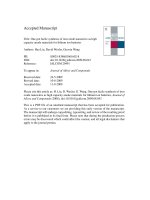
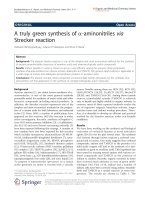
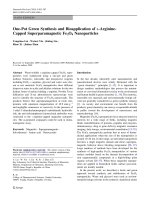
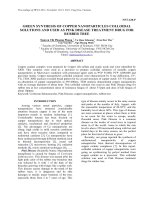
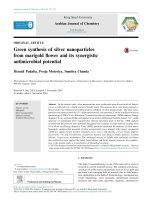



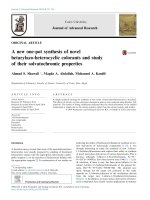
![Microwave assisted one-pot catalyst free green synthesis of new methyl-7-amino-4-oxo-5-phenyl-2- thioxo-2,3,4,5-tetrahydro-1H-pyrano[2,3-d] pyrimidine-6-carboxylates as potent in vitro](https://media.store123doc.com/images/document/2020_01/13/medium_tdv1578869850.jpg)